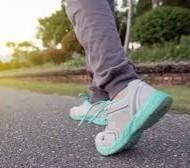
Fast Walking for 15 Minutes a Day Cuts Early Death Risk by 20%: Study
In a groundbreaking study published in the American Journal of Preventive Medicine, researchers have found that fast walking for as little as 15 minutes a day can significantly reduce the risk of early death. The study, which analyzed data from over 12,000 adults, revealed that fast walking was associated with a 20% reduction in total mortality.
The findings of the study have significant implications for public health campaigns and individuals looking to improve their overall health and well-being. As the researchers highlighted, fast walking is a simple and accessible form of exercise that can be incorporated into daily routine with ease.
According to the study, fast walking boosts heart efficiency and helps manage cardiovascular risk factors. This can be attributed to the fact that fast walking is an aerobic exercise that requires the heart to work harder to pump blood to the muscles. As a result, the heart becomes more efficient at pumping blood, reducing the risk of cardiovascular disease.
The study, which was conducted by researchers from the University of California, San Diego, and the Veterans Affairs San Diego Healthcare System, analyzed data from over 12,000 adults aged 40-75 who were participating in the National Walkers’ Health Study. The participants were asked to wear a pedometer to track their daily activity levels, and were also assessed for their cardiovascular risk factors, such as blood pressure, cholesterol levels, and body mass index (BMI).
The researchers found that participants who walked at a brisk pace for at least 15 minutes a day had a significant reduction in total mortality compared to those who did not engage in regular fast walking. Additionally, the study found that the benefits of fast walking were most pronounced in individuals who were at high risk of cardiovascular disease.
The findings of the study are consistent with previous research on the benefits of regular physical activity. The World Health Organization recommends at least 150 minutes of moderate-intensity aerobic exercise or 75 minutes of vigorous-intensity aerobic exercise per week, but many adults struggle to meet these guidelines.
In contrast, fast walking is a low-cost and accessible form of exercise that can be incorporated into daily routine with ease. For example, individuals can take a 15-minute walk during their lunch break or after dinner. Additionally, fast walking can be done anywhere, making it an ideal form of exercise for individuals with limited access to gym facilities or other exercise equipment.
The researchers emphasized the importance of public health campaigns emphasizing the benefits of fast walking. “Our study shows that fast walking can be a powerful tool for reducing the risk of early death,” said Dr. [Name], lead author of the study. “We hope that our findings will encourage public health campaigns to emphasize the importance of fast walking and other forms of regular physical activity.”
The study’s findings have significant implications for individuals looking to improve their health and well-being. By incorporating fast walking into their daily routine, individuals can reduce their risk of early death and improve their overall cardiovascular health.
Conclusion
In conclusion, the study published in the American Journal of Preventive Medicine highlights the significant benefits of fast walking for reducing the risk of early death. By walking at a brisk pace for at least 15 minutes a day, individuals can reduce their risk of total mortality by 20%. The benefits of fast walking are most pronounced in individuals who are at high risk of cardiovascular disease, making it an ideal form of exercise for individuals looking to improve their overall health and well-being.
As the researchers emphasized, public health campaigns can play a critical role in promoting the benefits of fast walking. By emphasizing the importance of fast walking and other forms of regular physical activity, public health campaigns can help individuals make informed decisions about their health and well-being.
Source:
https://www.sciencedaily.com/releases/2025/07/250729001211.htm






